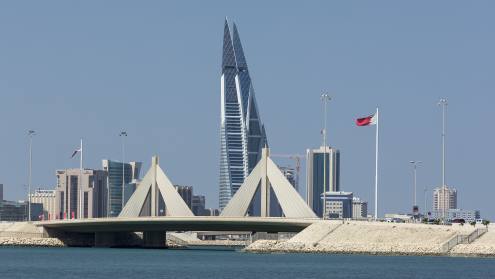Armenian banks are growing at a steady clip as a booming domestic economy lifts profitability, liquidity and capitalisation across the financial system. Surging immigration and capital inflows from Russia, stemming from the war in Ukraine, combined with a higher interest rate environment, have played a considerable role in this performance.
Rating agency Fitch’s research finds most lenders have benefited from higher non-interest income due to money transfers and currency conversion operations from newly arrived immigrants, and that profitability has been “underpinned by higher interest rates”.
The Central Bank of Armenia’s refinancing rate currently sits at 8.5 per cent, down from a peak of 10.75 per cent at the end of 2022.
Artem Beketov, director of financial institutions and banks at Fitch Ratings, says: “The key credit metrics of Armenian banks are at historic highs. We believe that for the next two years, these metrics will remain above average historical norms.”
According to Fitch, the average pre-tax return on equity for the country’s banking system reached 28 per cent in 2022 before falling to 17 per cent in 2023. But this compares with an average of 9 per cent between 2018 and 2021, indicating that Armenian banks’ profitability is still sky-high despite peaking in 2022.
Meanwhile, sector-wide capital and liquidity ratios are robust. Central bank data suggests that in February this year, the ratio of regulatory capital to risk-weighted assets stood at 17.08 per cent, while the ratio of liquid assets to total assets was 34.23 per cent.
“For this part of the world, the banks are very well capitalised and quite liquid. I think it’s a very positive environment [for the banking sector],” says George Akhalkatsi, head of the European Bank for Reconstruction and Development’s Yerevan resident office.
Dollarisation issues
Nevertheless, some concerns linger over the industry’s asset quality due to the relatively high rate of loan dollarisation. Although the ratio of sector-wide loans denominated in foreign currencies fell to 33 per cent at the end of 2023, down from 43 per cent in 2022, according to the central bank, key risks remain.
“The weakest link in the banking sector’s asset quality is high dollarisation. This problem is exacerbated by the fact that many borrowers taking loans in foreign currency are not naturally hedged,” says Beketov.
According to Fitch, about 57 per cent of all corporate loans are dollarised, compared with just 12 per cent of retail loans. However, the authorities are taking action to address this, including introducing a new law in late 2023 banning foreign exchange mortgages for borrowers not earning in foreign currency.
Beyond these concerns, positive business momentum will remain as the government ramps up capital expenditures in 2024 and key economic sectors such as information, communication and technology, as well as construction and agriculture, enjoy a sustained period of growth.
Most experts think the prospects for Armenia’s banks will remain strong over the short term.
Favourable operating conditions have, in part, helped drive a series of deals in Armenia’s banking industry. In February, Ardshinbank, the country’s largest lender by total assets, announced a binding agreement to acquire the in-country unit of HSBC for an undisclosed sum subject to regulatory approvals.
Artak Ananyan, chairman of the management board at Ardshinbank, says the “aim was not only to maintain [Ardshinbank’s] leading position in the Armenian banking system but also to integrate European banking standards into our operations”.
According to Ardshinbank, HSBC Armenia had total assets of 290bn ($732.7bn) drams and customer deposits of 185bn drams at the end of 2023.
Beyond this deal, Ananyan says, “new and aggressive future acquisitions are not excluded” as the bank looks to the future. Ardshinbank’s latest deal follows the acquisition of VTB-Armenia Bank’s retail loan portfolio in 2022.
Further consolidation
Experts say there is room for further consolidation in Armenia’s banking industry, which currently has 18 commercial banks serving a population of just under 3mn.
“We think consolidation trends will continue because the competition is quite high for such a small economy,” says Fitch’s Beketov.
Meanwhile, on April 3 2024, the London Stock Exchange-listed Bank of Georgia Group announced the completed acquisition of Ameriabank, one of Armenia’s largest lenders.
The deal is a landmark transaction for Armenia’s financial system in terms of international exposure, and a significant boost for Ameriabank’s growth ambitions.
Hovhannes Toroyan, chief financial officer at Ameriabank, says: “We view the recently closed transaction with the Bank of Georgia Group as a strategic move for our long-term growth.”
The new arrangement will see Ameriabank act as a standalone entity within the LSE-listed financial group. According to Toroyan, the deal will “open up new prospects for growth” and provide Ameriabank with “new opportunities and offers for [its] customers”.
“In a wider context, this development will contribute to the internationalisation of the Armenian financial sector and capital diversification; hence the transaction is expected to have a positive impact on the economy of the country as a whole,” he adds.
Digital revolution
Meanwhile, Armenia’s lenders are pushing ahead with ambitious digital transformation plans to cut costs, increase operational efficiency and improve customer service offerings.
The arrival of tens of thousands of tech-savvy new clients from the wider region is also helping to accelerate these efforts and catalyse the growth of a digital financial ecosystem in the country.
Armenia’s regional technology hub status shapes how the country’s banking sector approaches digital finance.
Ameriabank’s Toroyan says the lender is “aspiring to become a digitally native bank” and that fewer than 2 per cent of transactions are conducted through its physical branches.
“Our cash offloading ratio is about 85 per cent, online banking penetration is above 70 per cent, more than 95 per cent of loans are underwritten automatically through our scoring and machine learning models, and currently, more than 50 per cent of all sales are done through our digital channels,” he adds.
Lending to micro, small and medium-sized enterprises is one area of banks’ businesses that has benefited from technological innovation. SMEs account for about 70 per cent of total employment in Armenia, which also has double Europe’s rate of total early-stage entrepreneurial activity, according to research from the EU.
As a result, most Armenian lenders are pushing hard to capture a bigger share of the market.
Ardshinbank’s Ananyan says financing SMEs represents the bank’s “main strategic direction” and that its digital solutions are specifically designed to save customers time through online onboarding services and key banking functionalities on the web and in the mobile app.
Ameriabank’s Toroyan says SME financing expanded by more than 30 per cent in 2023, while its total SME client base has trebled over the past three years. The lender believes its “SME ecosystem platform” is a key driver of this success, saying it offers flexible loan structures, reduced processing times and simple applications.
“Some 72 per cent of SME loans under 10mn drams in 2023 [were] processed online through this platform,” says Toroyan.
A geopolitical dilemma
Armenia’s banks have not been immune to the geopolitical headwinds that have affected some parts of the domestic economy and the wider region.
In March this year, almost all of the country’s lenders stopped processing payments executed through Russian “Mir” cards in compliance with US sanctions. Experts say the costs of this action were low, given that the Mir system only applies to card payments and not to account-to-account transfers.
Nevertheless, Armenian banks’ compliance costs have spiked due to growing geoeconomic divisions between Russia and the West and the preponderance of new Russian account holders in Armenia’s banking system.
“Banks have increased investments in compliance and know-your-customer, so they’re aware of the potential risks associated with rising deposit inflows,” says Fitch’s Beketov.
“Maintaining direct correspondent accounts with western banks is one of the pillars of the banking sector’s profitability, as international money transfers and currency conversions prop up sector profits.”
According to Ardshinbank’s Ananyan, the lender’s compliance headcount has recently trebled to handle the growing complexity and caseload of anti-money laundering and sanctions requirements.
“Armenia is at the crossroads of geopolitical interests and strives for the peaceful resolution of its long-standing conflicts, which is a tough task. Our bank has responded [by] strengthening the compliance and AML and sanction staff resources, both in terms of quantity and quality,” he says.
Looking ahead, most Armenian lenders are well-placed to benefit from sustained growth in the domestic economy. With greater government spending forecast for the coming year, rising private consumption and an expanding suite of foreign investments, conditions will remain favourable over the short term.










